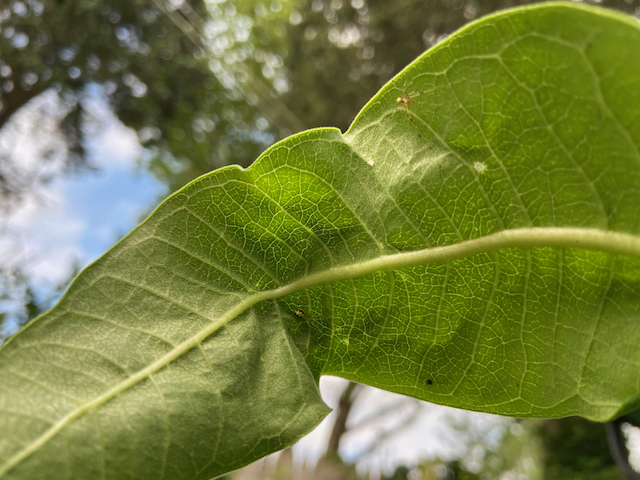I’ve never seen an adult yellow garden spider (Argiope aurantia) in my garden. Not that I don’t keep my eyes out for them. They’re huge and intimidating (though harmless to humans and other non-insects) and I want to know their whereabouts if we’re going to be sharing a workspace. I’ve spotted them in other gardens — usually when my face was suddenly within 5-inches of a zig-zagged web, herself smack in the center like a benevolent boss. But I’ve never seen one here. Pretty sure. My memory is terrible but I think I’d remember that. Today though, during a routine inspection of a milkweed I wanted to evict (I was checking of course for monarch butterfly eggs first), I spotted two teeny weeny yellow and black spiders on the underside of a leaf. Could such a giant ever be so tiny? Shouldn’t they be bigger by July anyway? Whoever they are, the errant milkweed will stay, in the wrong place, as most of my plants are, and my fingers are crossed the spiders continue to grow to scary size adulthood.

She’s in the crook of the leaf… and the other is out of focus near the top.
Now that I write this, I can’t help wondering (half remembering, second guessing) if I’ve written it before. Which means maybe I’ve encountered yellow garden spiders in my garden all along. And maybe this wondering (half remembering, second guessing) is why I stopped writing.

 My tastes range too far-and-widely and I have too little impulse control when I’m plant shopping to ever be called a native plant fanatic. But I am a big fan. (You know I beat their drum every chance.) I have always valued natives for their common sense usefulness: for being likely to survive and thrive the climate and soil profile in my garden with little to no supplemental encouragement. But it wasn’t until I read Doug Tallamy’s book Bringing Nature Home that the other common sense reasons to plant natives hit… well… home. Now that I understand how essential they are for providing ecosystem services; for feeding the bugs that feed the birds, I have made a point of adding New England and Rhody native plants to my shopping list every year — and sticking to it.
My tastes range too far-and-widely and I have too little impulse control when I’m plant shopping to ever be called a native plant fanatic. But I am a big fan. (You know I beat their drum every chance.) I have always valued natives for their common sense usefulness: for being likely to survive and thrive the climate and soil profile in my garden with little to no supplemental encouragement. But it wasn’t until I read Doug Tallamy’s book Bringing Nature Home that the other common sense reasons to plant natives hit… well… home. Now that I understand how essential they are for providing ecosystem services; for feeding the bugs that feed the birds, I have made a point of adding New England and Rhody native plants to my shopping list every year — and sticking to it.